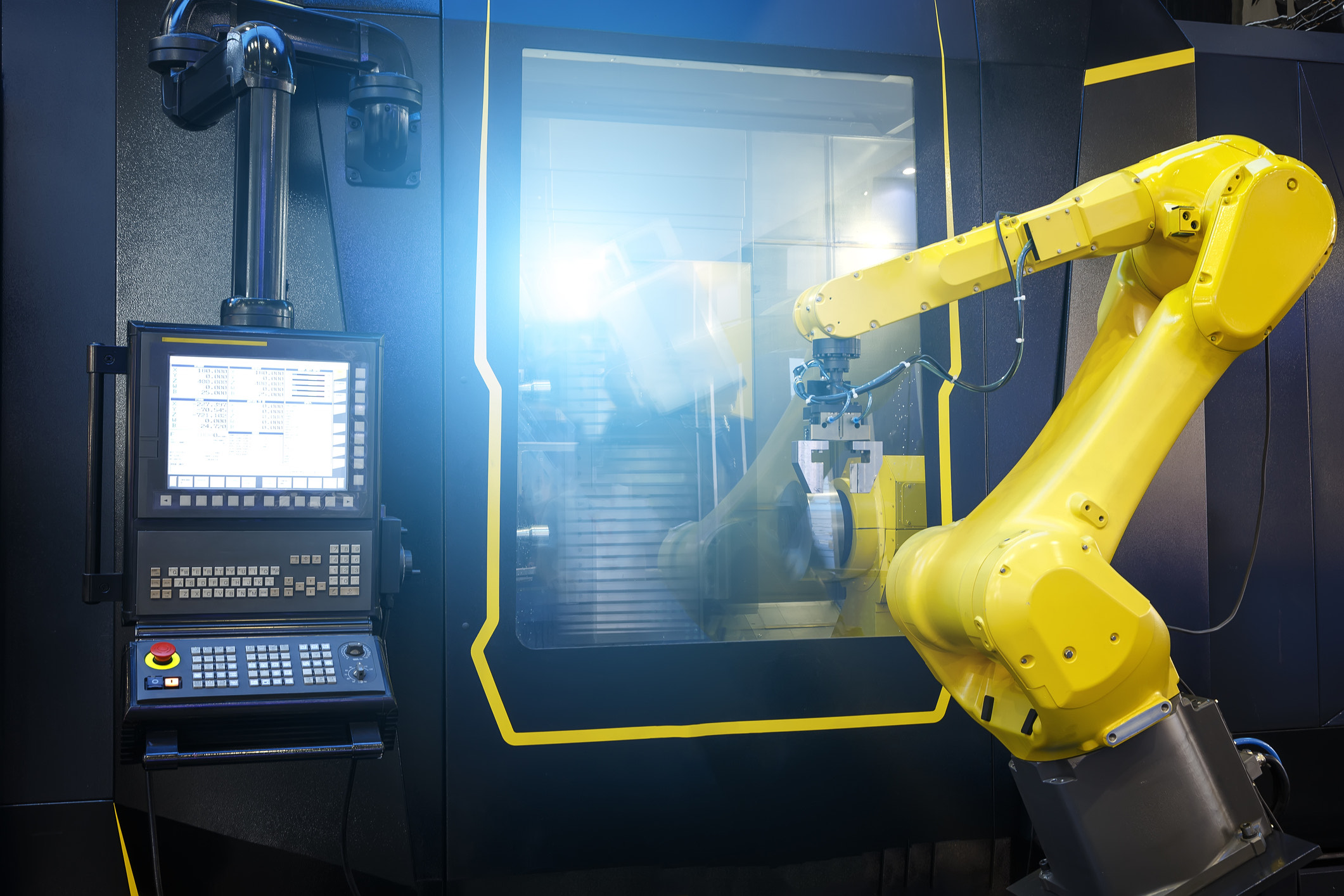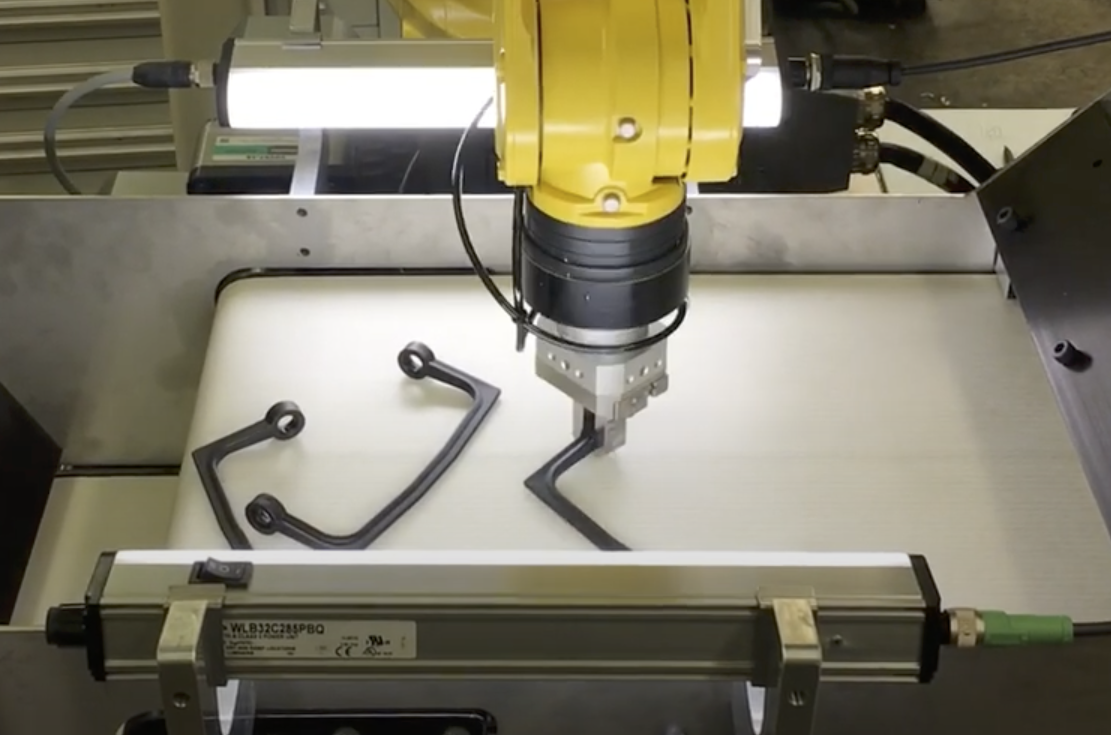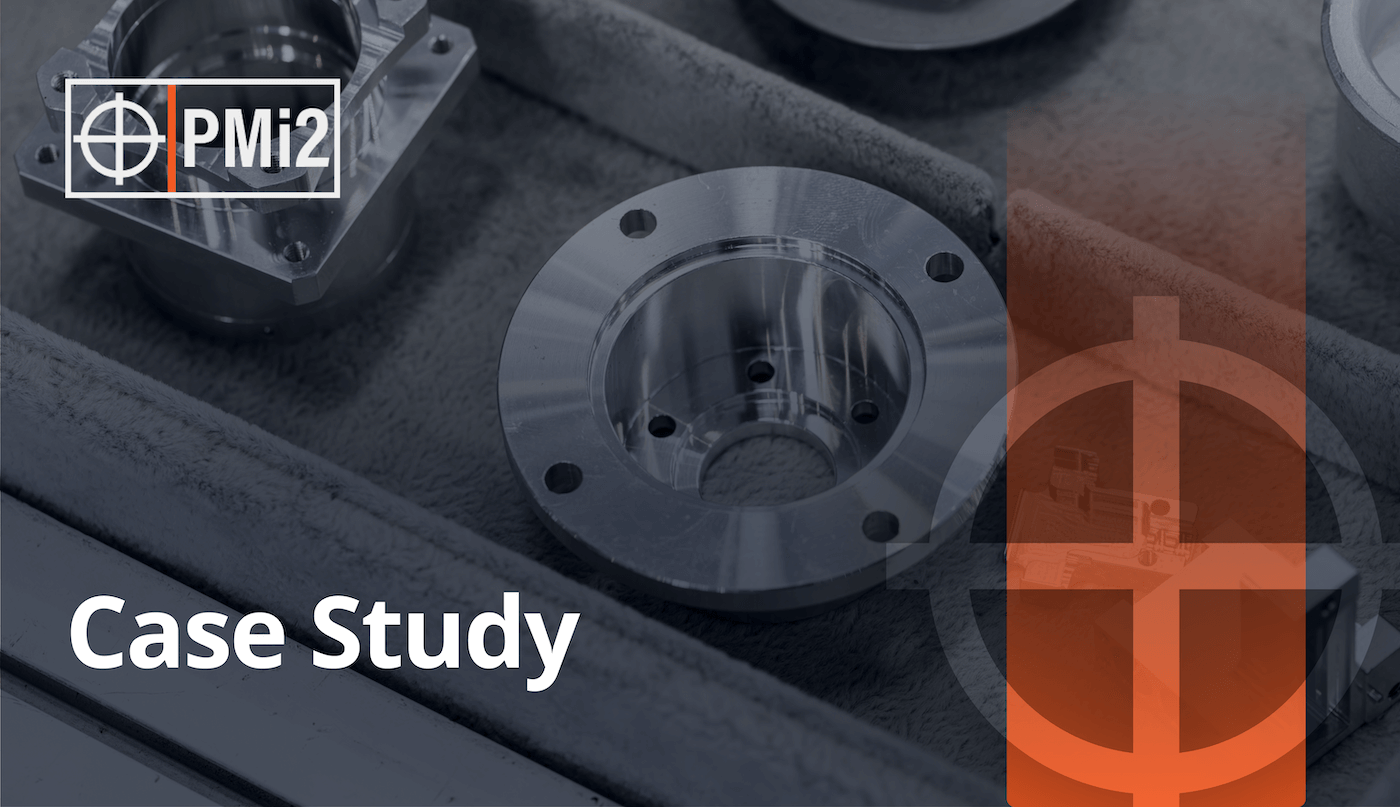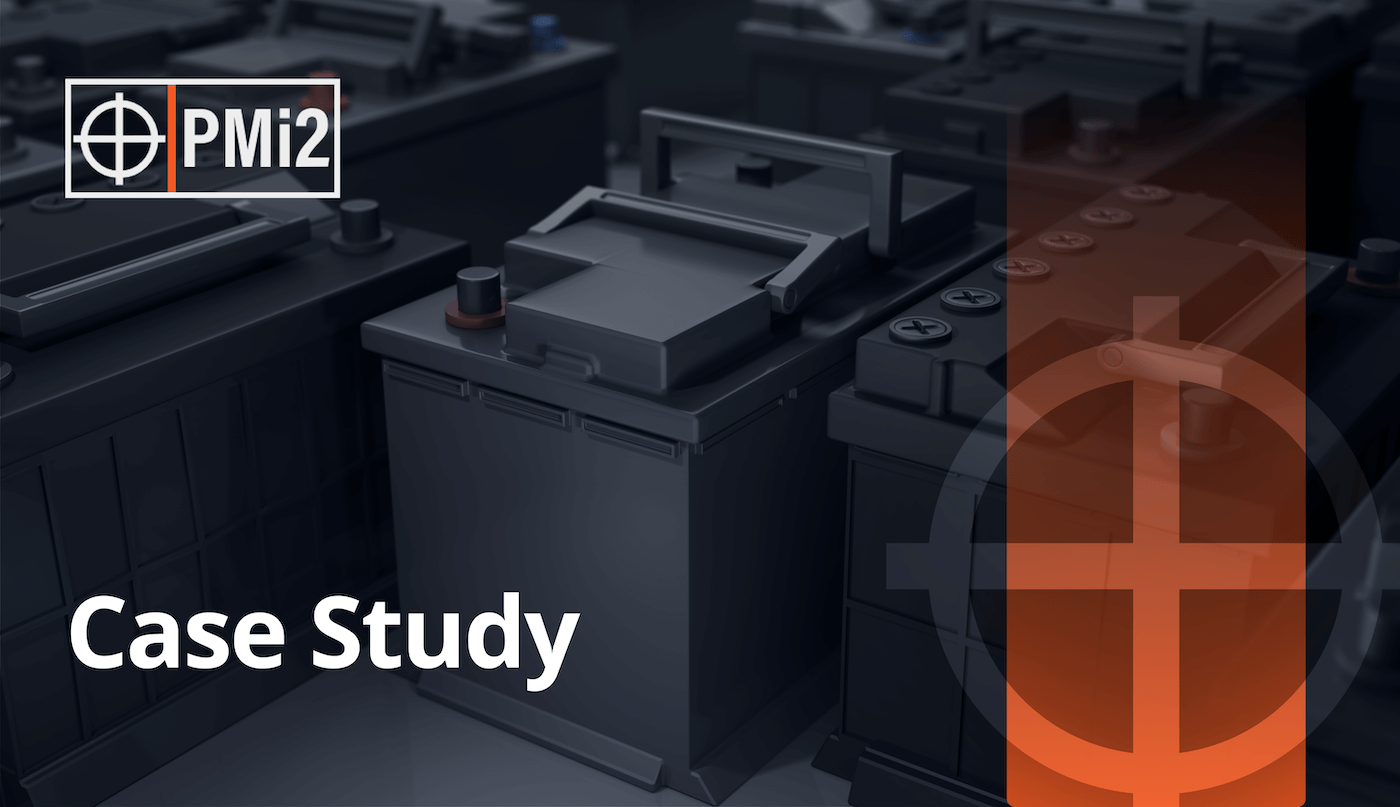Profitable Automation Solutions for Automotive Suppliers
The automotive industry is under siege.
Supply chain shortages are crippling production, making raw materials more difficult to source. Labor costs are skyrocketing, and skilled workers are scarce. Regulations force manufacturers to meet demands and rethink processes. And the uncertainty surrounding tariffs adds another layer of risk, leaving companies unsure how future costs and global competitiveness may be affected.
At the same time, demand is outpacing capacity, while defect rates are threatening contracts and reputations.
“We like automation because it empowers our customers to boost quality, accelerate production, and innovate faster than ever before.” – Eric Cline
If you're in automotive manufacturing, this stuff keeps you up at night.
Despite these pressures, the industry is not standing still. Automotive leaders are responding with decisive action, looking for ways to build resilience, boost efficiency, and protect their bottom line in a volatile market.
One of the most powerful tools to counter many of these challenges is automation. Modern manufacturers have incorporated it into nearly every automotive production stage, from raw material processing and component fabrication at Tier-1 and Tier-2 suppliers to the final vehicle assembly.
By the Numbers
Robot density, a core metric cited by the International Federation of Robotics (IFR), underscores the impact of automation across the top car-producing countries. In 2021, South Korea led with 2,867 robots per 10,000 employees; followed by Germany at 1,500; the U.S. at 1,457; and Japan at 1,422.
There’s ample opportunity for automation. Automation solutions span the supply chain to reduce labor demands, increase throughput, and improve production consistency. Companies leverage robotics, intelligent machines, and advanced control systems to streamline operations and enhance quality.
Experienced automation engineering partners, like South Carolina-based PMi2, ensure solutions they design and build for customers in automotive are tailored and integrated efficiently, maximizing the benefits of automation integration.
“Automation goes beyond labor savings,” said Eric Cline, owner and CEO of PMi2. “We like automation because it empowers our customers to boost quality, accelerate production, and innovate faster than ever before,” he said.
Manufacturing and Assembly Automation
Automation can be applied to virtually every aspect of automotive manufacturing and assembly. Automated systems are transforming most factory operations, with several key areas demonstrating significant impact.
The possibilities go beyond the familiar use of robots on the assembly line. Today’s solutions range from advanced vision inspection and precision part placement to automated testing, sorting, and flexible feeding systems.
So with all its proven benefits, what is slowing the adoption of automation? Many manufacturers may not yet realize the extent to which repetitive, quality-critical, or labor-intensive tasks can be automated, often in ways that go beyond traditional approaches.
By exploring the spectrum of automation technologies now available, automotive companies can achieve new levels of efficiency, quality, and reliability throughout the production process. Here’s a look at what’s possible–and this is only the beginning.
Automated Testing Solutions
Quality control is critical in automotive production, and automated testing systems ensure each component meets design and performance specifications. Using sensors, vision systems, and specialized instruments, these solutions rapidly detect defects or deviations far more reliably than manual checks.
- Vision Inspection: High-speed cameras, often with incorporated AI software, inspect parts or assemblies for surface defects, missing components, or misalignments. Vision systems can verify that welds or paint jobs are correct and catch flaws that human inspectors might miss.
- Flow Testing: Automated flow testers push air or fluid through components like fuel lines, cooling systems, or valve bodies to confirm proper flow rates and check for blockages. This helps guarantee performance and can detect internal obstructions early.
- Pressure Decay Testing: A leak-testing method where a part, such as a tank, hose, or casting, is pressurized and monitored for pressure loss. Automation of pressure decay tests allows 100% leak checks on items like battery containers, brake lines, or engine blocks, preventing defective components from reaching assembly.
- Eddy Current Inspection: Electromagnetic fields detect tiny cracks or flaws in metal parts. An automated eddy current system scans each part in seconds, finding subsurface defects that visual inspection would miss. Eddy current inspection can also be used to verify the hardness of steel parts.
- Inductive Measurement: Non-contact measurement using induction sensors to check dimensions or metal properties. For instance, inductive probes can verify that a steel part’s thickness, runout, or position is within tolerance as it moves down the line, even in very dirty environments
- Laser Profile Measurement: Lasers scan a part’s surface or profile to measure shape, flatness, or alignment. In body assembly, laser profilers can check gaps and flushness of panels or measure weld bead profiles to ensure proper joins.
- Vibration Testing: Bearings, motors, and rotating assemblies can be 100% inspected during assembly using sensitive accelerometers to ensure they meet manufacturers noise and vibration specifications.
- Torque Testing: Involves automatically measuring the rotational force required to turn or fasten a component. For example, an automated rig may verify the torque of rotating parts or check that fasteners have been tightened to spec.
- Hardness Testing: Assembly systems can perform hardness indentation tests on metal parts to ensure the effectiveness of heat treatments. This guarantees that critical components have the required strength and wear resistance.
- Contact Measurement: Automated gauges or probes physically contact parts to measure dimensions. On a production line, a robotic gauge might measure each machined part to catch any out-of-tolerance parts.
- Hi-Pot / Dielectric Testing: High-voltage tests on electrical components such as battery assemblies, wiring, or electronic modules verify insulation integrity. Automation allows every unit to be tested for electrical safety without risking operator exposure.
- Checkweighing (Weight Inspection): Parts or kits are automatically weighed to verify that all required pieces are present. For instance, an automated scale can ensure an airbag module has all subcomponents by weight, flagging any discrepancies for removal.
- Conductivity and Resistance Testing: Automated electrical testers measure conductivity or resistance in wiring harnesses, sensors, or circuits to ensure proper electrical performance. This catches wiring faults or bad connections immediately prior to assembly.
Automated Assembly Operations
Robotic and automated assembly systems consistently and efficiently join components. These systems handle everything from welding to fastening, often much faster and more precise than manual assembly.
- Ultrasonic Welding: High-frequency vibrations weld together plastic parts or embed metal pieces in plastic. Automation of ultrasonic welding is standard for assembling items like interior trim components or electronics housings, creating strong bonds without adhesives and in cycle times of just seconds.
- Thermal Beading: Joins plastics by melting and reforming material into a bead or rivet shape. Automated thermal staking or beading machines assemble things like automotive lighting housings or under-hood plastic components, producing a secure joint that withstands vibration.
- Mechanical Assembly: General automated mechanical operations such as snap-fitting parts, inserting clips, or assembling sub-components. Robots or dedicated machines can perform repetitive assembly steps like placing springs, plugging in connectors, or clipping panels, with high speed and zero fatigue.
- Hot Plate Welding: A heated platen melts the surfaces of two plastic parts, which are then pressed together to form a weld. Automated hot plate welders are used for components like fluid reservoirs, molded plastic battery components, or intake manifolds, producing uniform, leak-proof joints.
- Screw Driving: Robotic or fixed screw-driving units automatically drive screws or bolts to the correct torque. Automation ensures each fastener is tightened accurately, improving quality and freeing workers from tedious screw driving tasks.
- Riveting: Machines or robot-mounted tools set rivets consistently in chassis components, airbag assemblies, brake pads, and more. By automating riveting, manufacturers achieve reliable fastening without the variability of manual riveting.
- Spot Welding: A classic in automotive body shops, robotic spot welders join metal panels by applying pressure and electrical current to “spot” weld them. In addition to car bodies, smaller spot welding stations automate the assembly of brackets, battery packs, and wire assemblies, ensuring strong, repeatable welds at high production rates.
Other Custom Assembly Operations
A customized solution can automate most repetitive assembly processes. Whether it’s precise adhesive dispensing, automated gluing, clip installation, or spring placement, specialized machines can be designed to meet the exact assembly requirements of various automotive components. These tailored systems boost efficiency, ensure consistency, and adapt seamlessly to the unique challenges of each production line.
Component Insertion & Placement
Beyond welding and fastening, many assembly processes involve precisely inserting components or sub-parts into assemblies.
- Press-to-Set Depth: Automated press systems insert parts into housings or assemblies until a precise depth is reached. The machine applies force and monitors position, guaranteeing, for example, that a bearing is seated exactly flush in its bore.
- Press-to-Set Force: Similar to press-to-set-depth, the focus is on achieving a target force. For instance, an automated press might insert a rubber plug until a specified force indicates it’s properly sealed. This ensures a consistent fit without over-pressing, which could damage parts.
- Precision Part Placement: Robotic arms or high-speed pick-and-place machines can accurately position and assemble delicate or small components. This improves build quality, especially for intricate assemblies, and prevents misalignment issues that could occur with manual handling.
Part Alignment Before Assembly
Proper alignment of parts is often necessary before joining or assembly. Automation can handle this critical positioning step using either advanced vision or clever mechanical design.
- Alignment with Machine Vision: Vision-guided robots use cameras to locate parts and align them in real time. For example, a camera identifies the orientation of a loose part coming down a conveyor, and a robot adjusts its grip or the part’s position before assembly. This is crucial when assembling components requiring precise mating, like aligning a windshield with a car body or positioning a gear in a transmission. Vision ensures everything lines up despite variations.
- Mechanical Alignment: In some systems, engineered funnels, guide pins, or fixtures automatically align parts during feeding. For example, a part might travel along a chute that positions it correctly, or a system may use chamfered edges and guide pins so that two parts naturally align as they're pressed together during assembly.
Sorting and Categorizing Parts
Beyond automated assembly and testing, automation systems sort and organize components based on specified criteria. This is especially useful in handling mixed parts or separating good parts from bad.
- Sorting Verified vs. Rejected Parts: Automated systems divert parts that passed inspection one way and route failed parts to a reject bin. For example, after an automated test, a pneumatic pusher might separate any failed part, preventing it from moving further down the line. This ensures only verified components continue in production, supporting 100% quality containment.
- Sorting Based on RFID Data: Many automotive parts incorporate RFID tags or barcodes. Robots or conveyors equipped with scanners identify these tags and sort parts accordingly. For instance, an automated system might read a part’s RFID to determine its model variant or destination, then direct it on a designated path. This reduces mix-ups in high-mix manufacturing environments.
- Sorting by Measurement or Grade: Automation groups parts based on size or measurement results. Consider that when an in-line measurement finds variations in part dimensions, variability in a part’s dimensions, an automated sorter can group parts by size. For example, pistons and cylinder bores that fit best together can be matched during assembly. This optimizes fits and reduces scrap.
- Mixed-Part Separation (Bin Picking and Flex Feeding): In processes like bin picking or flexible feeding, a vision-equipped robot can identify and sort random types of parts mixed in a bin or on a feeder. For example, if two different fasteners are accidentally mixed, a vision-guided robot could distinguish and sort them into separate containers. Automation in sorting prevents parts from mistakenly being assembled.
Conveyor Systems
Efficient automotive parts movement between operations requires custom automated conveyor systems, which are often integrated with assembly processes.
- Custom Flat Belt Conveyors: These standard conveyors are tailored to width, length, and speed to move parts or assemblies between stations. For instance, a flat belt conveyor might transport engine blocks from one assembly stage to the next in an engine assembly line. Custom automation synchronizes conveyor timing with robots or machines loading or unloading parts.
- O-Ring (Round-Belt) Conveyors: These conveyors are great for lighter components or where minimal contact is needed. They often carry smaller parts between processes and can be designed to accumulate parts without damage.
- Pallet Conveyor Systems: In many automotive assembly lines, parts are mounted on pallets or fixtures that travel along a conveyor. Pallet conveyors ensure that each part remains properly oriented and can be precisely located for robotic operations. For example, a car door on a pallet conveyor can be stopped exactly in front of a welding robot. The robot recognizes the door’s position from the pallet fixture, completes the welds, and then the door moves on. Robust pallet systems handle heavy components like engine assemblies while maintaining consistent positioning at each station.
Part Feeding Equipment
Getting loose parts oriented and delivered to the right place is another automation challenge solved using specialized feeding systems. These systems supply robots or machines with a stream of correctly oriented parts.
- Flexible (Flex) Feeding Systems: These use a combination of bulk feeders, shakers, and vision systems to present randomly oriented parts to a robot. A platter gently vibrates small clips or fasteners, while a camera checks their orientation so a robot can pick them up correctly. Versatile by design, flex feeders handle various part shapes with quick recipe changes, making them ideal for automotive lines that may run multiple part types.
- Bin Picking Solutions: In a bin-picking setup, a robot equipped with a 3D imaging or vision system selects parts from a bin where they’re jumbled. Advanced software identifies which parts are accessible and guides the robot’s arm to pick one without collisions. This is used for tasks like picking forgings or castings from bulk containers and placing them into machines. Replacing manual bin picking with automation improves safety and runs continuously.
- Step Feeders: A feeding mechanism lifts and aligns parts from a bulk hopper. These are useful for larger or heavier parts that vibratory bowls can’t handle. For example, a step feeder might singulate and orient bolts or bushings, feeding them down a track to an assembly robot. This ensures a continuous feed without jams, at a pace matched to the line’s needs.
CNC Machining Automation

Automotive components like engine blocks, transmission gears, and brake calipers often require extensive machining. Automating CNC machining processes significantly boosts efficiency and consistency.
- Robotic Machine Tending & Palletizing: Robots are frequently used to load and unload CNC machines, lathes, or machining centers. A robotic arm picks a raw casting from a pallet, loads it into a CNC fixture, and unloads the finished part to a pallet or conveyor. Integrated automated palletizing and depalletizing reduces human involvement, resulting high machine utilization and reduced labor costs. One robot can tend multiple machines.
- In-Line Inspection & Vision Systems: Modern machining integrates quality checks directly into the process. For example, a vision system or sensor station might measure a critical dimension or check surface quality following a machining operation. Catching a defect immediately allows the line to stop or divert the part, preventing scrap.
- Advanced Fixturing & Workholding: Custom automated fixtures secure parts during machining or assembly operations. Innovations like adaptive workholding add flexibility to automated lines. Robots or automated slides can quickly swap quick-change fixtures, allowing machines to switch rapidly between different part types. These smart fixtures hold each part securely, improving precision and enabling automated changeovers without manual setup.
- Integrated Metrology Systems: For high-precision parts, coordinate measuring machines (CMMs) or laser measurement stations measure the dimensions and geometric features of components to verify they meet design specifications and tight tolerances. CMMs can relay measurement data directly to machine tools, allowing automatic adjustments to tool offsets as needed. By verifying each part’s accuracy, manufacturers see 30–50% fewer defective parts going to the next stage and extending machine tool life by avoiding operations on already-bad parts.
- Automated Tool Monitoring: Sensors on machine tools predict tool wear or breakage. This predictive maintenance can schedule tool changes or maintenance exactly when needed, avoiding unexpected downtime. It ties into the broader predictive maintenance trend discussed later, improving equipment's operational availability.
- Combination of Bin Picking with Machining: Many machining cells use bin picking or flex feeding to supply raw parts to the robot feeding the machine. This eliminates the need for an operator to stage each raw part. By pairing flexible feeding with machine-tending robots, even irregular raw parts can be automatically loaded, reducing labor and increasing throughput.
Electronics Manufacturing Automation
Vehicles depend on various electronic components and modules, and automation is essential to their efficient and reliable production.
- Pick-and-Place Robots for PCBs: Automated pick-and-place machines populate printed circuit boards (PCBs) with tiny electronic components such as resistors, chips, and connectors at blinding speeds and accuracy. In automotive electronics, these robots ensure every component is placed correctly on circuit boards, supporting the high quality required for safety-critical electronics.
- Wave and Reflow Soldering: Automated soldering processes take over after components are placed on boards. In wave soldering, for example, an entire board bottom is passed over a wave of molten solder to attach components. Reflow soldering uses precise ovens to melt solder paste applied to boards. Automated handling equipment carries boards through these processes on conveyors with controlled timing. This yields soldered assemblies with uniform quality and minimal human handling.
- Wire Cutting and Stripping Machines: Machines cut wires to exact length, strip insulation, and even crimp terminals on the ends for wiring harnesses and cable assemblies. These systems process wires much faster than manual handling, with nearly zero length or strip length mistakes.
- Crimping and Connector Assembly Tooling: Robots and special-purpose machines insert wires into connector housings, crimp contacts, and screw on connector collars or perform continuity tests. Automating these tasks ensures every connection is secure and correctly positioned, critical for complex automotive wiring systems like those in advanced driver assistance systems or EV battery management.
- Robotic Assembly of Electronic Modules: Beyond circuit boards, many electronic parts must be assembled into housings or mated with mechanical components. Robotic arms assemble components like transmission control modules, where a circuit board must be fitted into a casing with seals, screws, and connectors. Automation improves precision – ensuring that a delicate PCB isn’t cracked during assembly and that all screws are uniformly torqued.
- Hi-Pot and Dielectric Testing: Automated high-potential testing is crucial in electronics manufacturing. After assembly, a robotic tester probes the module’s pins or connectors and applies high voltage to verify insulation and the absence of short-circuits. In an EV battery management system or an airbag control unit, 100% dielectric machine testing guarantees that every unit is safe and functions as intended.
Empowering Automotive OEMs
Leading automotive manufacturers rely on PMi2 to support production.
View Our Capabilities
These advanced automation solutions, spanning everything from assembly and testing to part handling, are transforming how automotive components are produced. They enable manufacturers to achieve levels of speed, precision, and consistency that were once unimaginable, while also opening the door to innovations and production strategies.
But to fully appreciate the true scope of automation’s impact, it’s helpful to step back and examine how these technologies are integrated across the entire automotive manufacturing process, stage by stage.
Key Stages in Automotive Manufacturing
Automotive manufacturing is defined by tightly integrated production environments, with efficiency and precision engineered into every phase. Far beyond isolated robotic cells, modern plants deploy coordinated automation platforms, advanced controls, and real-time data analytics to orchestrate complex workflows across the entire value chain.
It’s helpful to consider the big picture of automotive production, from start to finish. Automation plays a role in most key stages.
- Raw Materials Processing & Preparation: This includes initial handling of steel, aluminum, plastics, etc. Examples include automated stamping of sheet metal, robotic die-casting of aluminum parts, and automated plastic injection molding of interior components.
- Component Production: Involves making individual parts via machining, molding, casting, or stamping. Many Tier-1 and Tier-2 suppliers focus on this stage. Automation here involves CNC machining centers, robotic cells, injection molding machines with automatic part ejectors and pickers, etc., to efficiently produce engine parts, suspension components, body panels, and more.
- Assembly and Welding: Focuses on joining components into larger sub-assemblies. This ranges from welding car frames to assembling smaller modules like axle assemblies or door modules. Robots, automated screwdrivers, and press-fit machines are widely used here.
- Electronics Integration: Involves producing and installing electronic systems, such as assembling battery packs, manufacturing wiring harnesses, and installing sensors and control units into the vehicle. Automation helps in PCB assembly, harness fabrication, and even robotically guiding harnesses through car bodies during installation.
- Painting and Coating: The vehicle body painting process is famously automated. Multi-axis robots spray-coat cars in paint booths to achieve even coverage and capture overspray. Automation also handles processes like electro-deposition and powder coating of parts, ensuring high-quality finishes under safe conditions.
- Final Assembly: This is where the car really comes together, as the engine, transmission, chassis, and body are integrated, and the interior trim is added. Traditionally labor-intensive, final assembly now sees increasing automation in tasks like windshield insertion, heavy lifting, and cobots, short for collaborative robots, assisting humans by presenting parts or doing under-dash work.
- Logistics and Material Handling: Even after production, automation continues with automated guided vehicles (AGVs) or autonomous mobile robots moving parts between stations or storing them in warehouses. Palletizing robots stack finished goods or components for shipment. In some factories, automated storage and retrieval systems (AS/RS) manage the inventory of parts feeding the lines, ensuring just-in-time delivery.
PMi2 Success Stories in Automotive Automation
PMi2 applied automation expertise to solve these real challenges, improving efficiency, reducing costs, increasing product quality, and ultimately helping manufacturers achieve fast returns and maintain a competitive edge.
Automated transmission Bearing Assembly Reduces Labor, Increases Quality, and Output for Tier-1 Powertrain Supplier
A Tier-1 supplier assembled automotive bearings using semi-automatic machines that required one human operator per machine. After each assembly, parts had to be manually moved to separate stations for inspection before shipment.
PMi2 designed and built an automated assembly cell consisting of four machines working in parallel.
This new cell needs only one operator to oversee four machines, yet each produces as much output as four old semi-automatic setups. In effect, one automated cell does the work of 16 manual stations.
|
Highlights
|
Because the plant runs three shifts, the labor saving equates to eliminating roughly 45 operator shifts across all shifts, freeing those workers for other tasks in a tight labor market.
Also, the automation solution performs a 100% in-line inspection, eliminating the previous separate inspection step and labor.
The results were dramatic.
The considerable labor reduction and throughput increase yielded a payback period of under nine months. The company redeployed many of the operators to more value-added roles and saw a significant boost in consistency and quality of the bearing assemblies.
Domestic Automation Upgrade Delivers Simpler, Faster Battery Production
An international automotive battery manufacturer must produce a particular battery component in its U.S. plant. The part had traditionally been made in Europe using European-built automated systems.
The manufacturer was concerned about relying on overseas equipment and support, and saw an opportunity to rethink the design.
Initially, they considered simply copying the European machine design with U.S.-sourced components. Instead, they contacted PMi2 to review the design, where engineers identified several design simplifications and improvements.
|
Highlights
|
The PMi2 team built a “U.S. version” of the equipment that was much simpler, more streamlined, and easier to maintain with locally available parts.
Despite a simpler design, the new system increased output by about 10% while occupying only 60% of the floor space of the older equipment.
It was also less expensive upfront and is expected to be more reliable long-term because of fewer complex components.
By sourcing the automation domestically through PMi2, the company gained a local support team for ongoing service. This project demonstrates how re-engineering an automated solution can deliver significant efficiency and cost improvements instead of simply duplicating an old design. It also highlights the value of having an experienced automation partner.
Automation Solutions and Expertise
As automotive manufacturers strive to modernize and streamline operations, contract automation and engineering firms like PMi2 are offering expertise to meet these challenges.
“Our mission is to help clients focus on what they do best, while we handle the complexities of automation,” says. “We believe smart, flexible automation isn’t just for the largest companies. Every manufacturer should have access to technology that makes them more competitive.”
- Assembly & Testing Systems: Turn-key automated assembly lines and test stations for powertrain components and battery packs. These systems often integrate the testing and assembly operations discussed above into cohesive cells, as seen in the bearing case study.
- Robotics Integration: Deployment of industrial robots for tasks like welding, material handling, machine tending, and part transfer. For example, PMi2 has implemented Fanuc robot-based systems for automotive electronics manufacturers, such as robotic soldering and fine spot welding tools for circuit board assemblies.
- Custom Machining and Fixturing Solutions: Combining precision CNC machining capabilities with automation, PMi2 delivers custom machining cells, including EDM and milling, with automated part loading and unloading and in-process quality checks. They also design custom tooling and fixtures, including end-of-arm tooling for robots and flexible feeders to ensure smooth automotive parts handling.
- Flexible Feeding & Bin Picking: PMi2 has developed systems for automated part feeding in automotive lines, from vibratory bowls and step feeders to advanced vision-guided flex feeding. These solutions have been used to feed parts in tire manufacturing equipment, battery assembly, and more, reducing manual sorting and orientation tasks.
- Automated Inspection Systems: Quality inspection machines custom-built for automotive components. Whether it’s a stand-alone vision inspection station for an injection-molded part or an inline measurement for a machining process, PMi2’s solutions emphasize 100% reliable inspection so that defective parts are caught before they proceed.
Beyond areas where they’ve already delivered solutions, PMi2 continues to expand its automation capabilities. The company applies its expertise to emerging and traditionally manual processes, including advanced interior assembly and AI-enabled predictive maintenance.
Strategic Automation Sets Industry Leaders Apart
The secret isn’t to automate everything, but to target the processes where automation delivers the biggest impact. Forward-thinking manufacturers who invest wisely in automation don’t just cut costs; they gain the agility to launch new models faster, scale up production at a moment’s notice, and deliver quality that earns loyalty.
“We don’t just build machines. We help our clients build the future of manufacturing,” – Eric Cline
Solutions aren’t ready-made. They require years of engineering skill and experience.
With a knack for spotting the high-ROI opportunities and the expertise to design, build, and support custom systems, PMi2 helps manufacturers turn automation from a buzzword into a real competitive advantage.
Manufacturers who recognize the signs and act proactively with automation often find themselves leapfrogging the competition. They reap direct cost and productivity gains, and they also build more resilient and flexible operations that can adapt to new models, ramp up output quickly, and maintain consistent quality that bolsters their brand.
“We don’t just build machines. We help our clients build the future of manufacturing,” Cline said.
Contact Us Discuss any of these automation solutions or something new.



